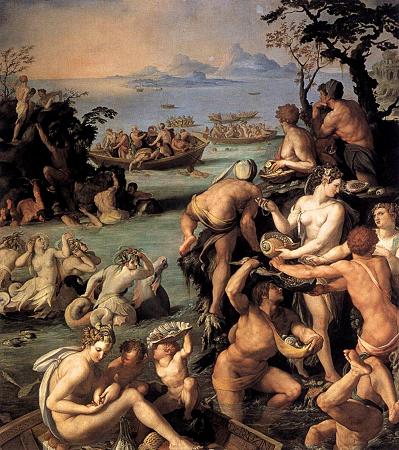Slate. Slate is a fine-grained metamorphic rock that has been used in various forms of art, including painting, for centuries. Its smooth surface and natural color variations make it a popular choice for artists looking for a unique and durable painting surface. Some artists use slate as a canvas for painting, either by applying paint directly to the slate surface or by using a special coating to create a smooth painting surface. Slate canvases can be used for both oil and acrylic painting, and the natural texture and color of the slate can add an interesting visual element to the finished artwork. Slate can also be cut into small tiles and used to create mosaics, which can be used to decorate walls, floors, and other surfaces. Slate mosaics can be created using a variety of techniques, including traditional mosaic methods and more modern approaches that incorporate other materials, such as glass or metal. Slate is the finest-grained foliated metamorphic rock. Foliation may not correspond to the original sedimentary layering, but instead is in planes perpendicular to the direction of metamorphic compression. The foliation in slate, called slaty cleavage, is caused by strong compression in which fine-grained clay forms flakes to regrow in planes perpendicular to the compression. When expertly cut by striking parallel to the foliation with a specialized tool in the quarry, many slates display a property called fissility, forming smooth, flat sheets of stone which have long been used for roofing, floor tiles, and other purposes. Slate is frequently grey in color, especially when seen en masse covering roofs. However, slate occurs in a variety of colors even from a single locality; for example, slate from North Wales can be found in many shades of grey, from pale to dark, and may also be purple, green, or cyan. Slate is not to be confused with shale, from which it may be formed, or schist. The word slate is also used for certain types of object made from slate rock. It may mean a single roofing tile made of slate, or a writing slate, which was traditionally a small, smooth piece of the rock, often framed in wood, used with chalk as a notepad or notice board, and especially for recording charges in pubs and inns. The phrases clean slate and blank slate come from this usage. Slate with pyrite Slate is a fine-grained, metamorphic rock that shows no obvious compositional layering but can easily be split into thin slabs and plates. It is usually formed by low-grade regional metamorphism of mudrock. This mild degree of metamorphism produces a rock in which the individual mineral crystals remain microscopic in size, producing a characteristic slaty cleavage in which fresh cleavage surfaces appear dull. This is in contrast to the silky cleaved surfaces of phyllite, which is the next-higher grade of metamorphic rock derived from mudstone. The direction of cleavage is independent of any sedimentary structures in the original mudrock, reflecting instead the direction of regional compression. Slaty cleavage is continuous, meaning that the individual cleavage planes are too closely spaced to be discernible in hand samples. The texture of the slate is totally dominated by these pervasive cleavage planes. Under a microscope, the slate is found to consist of very thin lenses of quartz and feldspar separated by layers of mica. These are typically less than 100 m thick. Because slate was formed in low heat and pressure, compared to most other metamorphic rocks, some fossils can be found in slate; sometimes even microscopic remains of delicate organisms can be found in slate. The process of conversion of mudrock to slate involves a loss of up to 50% of the volume of the mudrock as it is compacted. Grains of platy minerals, such as clay minerals, are rotated to form parallel layers perpendicular to the direction of compaction, which begin to impart cleavage to the rock. Slaty cleavage is fully developed as the clay minerals begin to be converted to chlorite and mica. Organic carbon in the rock is converted to graphite. Slate is mainly composed of the minerals quartz, illite, and chlorite, which account for up to 95% of its composition. The most important accessory minerals are iron oxides, iron sulfides, and carbonate minerals. Feldspar may be present as albite or, less commonly, orthoclase. Occasionally, as in the purple slates of North Wales, ferrous reduction spheres form around iron nuclei, leaving a light-green, spotted texture. These spheres are sometimes deformed by a subsequent applied stress field into ovoids, which appear as ellipses when viewed on a cleavage plane of the specimen. However, some evidence shows that reduced spots may also form after deformation and acquire an elliptical shape from preferential infiltration along the cleavage direction, so caution is required in using reduction ellipsoids to estimate deformation.
more...













